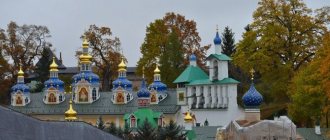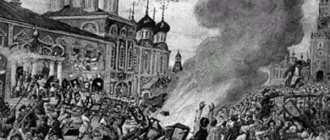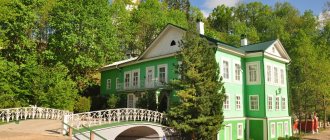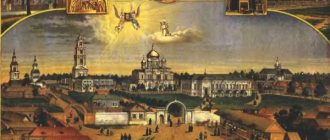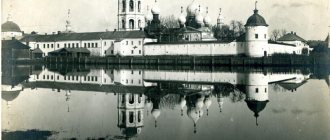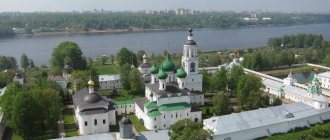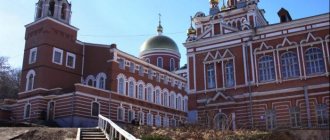In the very heart of Russia, in the Shatsky district of the Ryazan region, there is the village of Vysha, which received its name from the river of the same name, on the banks of which its houses are located. It owes its fame to the nearby Holy Dormition Vyshensky Convent, the history of which is connected with the name of an outstanding religious figure of the 19th century - Bishop Feofan (Govorov) the Recluse. Let's look briefly at the main events of his past and present.
Vague echoes of the past
There is no exact information about when and by whom the Assumption Vyshensky Convent, which is now operating in the Shatsk region, was founded. Nevertheless, based on the legends that have reached us, as well as some information gleaned from the book of Abbot Tikhon (Tsiplyakovsky), published in 1881, there is reason to believe that this happened during the time of Ivan the Terrible, that is, no later than the 16th century. The first written mention of him, dating back to 1625, is contained in a letter drawn up by the mother of Tsar Mikhail Fedorovich, nun Martha.
It is clear from the document that by her order (obviously, the sovereign’s mother had the proper authority to do so), the men’s monastery, located eight miles upstream from the current Vyshensky Assumption Monastery, was moved to a new location, located at the confluence of its navigable tributary into the Vysha - Tsny.
Since that time, the history of the monastery has been quite fully reflected in the surviving archival documents. The names of the abbots under whom the most large-scale construction work was carried out are known. These are hieromonks - Tikhon, who led the brethren from 1625 to 1661, and his successor Gerasim, who held the pastoral staff in his hands for the next 59 years. The names of other ministers have not reached us.
Monastery in the XVII-XVIII centuries
Founded presumably in the 16th-17th centuries (in written sources it was first mentioned in 1625 in a charter from the mother of Tsar Mikhail Fedorovich, Martha). The Vyshenskaya Assumption Hermitage was located on the left bank of the Vysha River, which in the spring threatened to flood the monastery. The monks turned to Mikhail Fedorovich with a request for a new place. Marfa Ioannovna granted the desert a charter of allotment, indicating a new (current) location.
From the day of its foundation until the revolution, the monastery was for men. Apparently, initially the monastery was not famous and rich, so already in 1724 it was assigned to the Cherneevsky St. Nicholas Monastery. Since 1764, the monastery regained its independence.
A series of troubles and hardships
In the history of the Vyshensky Assumption Monastery, which remained male until modern times, there were periods of prosperity and decline. So in the second quarter of the 18th century, the number of his brethren decreased so much, and the economy became so impoverished that by the decision of the Holy Synod he was abolished as an independent unit and assigned to the Cherneevsky St. Nicholas Monastery, located twenty miles away. The documents do not say what caused such a disastrous situation. Nevertheless, in subsequent decades, monastic service continued there.
A heavy blow was dealt to the Vyshensky Assumption Monastery during the period of the senseless and merciless Pugachev rebellion (1773 - 1775). Then crowds of maddened “God-bearing people” (L.N. Tolstoy’s expression), burst into the monastery, plundered the temple and stole everything that could be carried away. The monks, fortunately, were not touched, but were doomed to hunger and deprivation, completely undermining the already dilapidated economy.
Testimony of Hieromonk Leonty
Only towards the end of the century did life in the monastery gradually improve, as evidenced by the inventory of property compiled in 1798 by Hieromonk Leonty. In it, in addition to a detailed list of everything that the brethren owned, there is a record that the monastery, which was previously assigned, finally received independence, although it remained unemployed, that is, not receiving material support from the state.
Nevertheless, the author of the document indicates that it had a stone Assumption Church, next to which stood a bell tower covered with planks, and the entire territory was fenced with a strong wooden fence. The brethren's farm remained small: it consisted of hay cutting and a bee yard. Hieromonk Leonty also provides a detailed list of all the monks, indicating the time of their entry into the monastery.
Time for good changes
The next 19th century was the most fertile period in the life of the Vyshensky Assumption Monastery, which reached its greatest prosperity in the second half. This was largely facilitated by the transfer of the monastery to the jurisdiction of the Tambov diocese, then led by an outstanding religious figure of his era - Archbishop Theophilus (Raev). Thanks to his care, the brethren were able to rebuild dilapidated and unusable premises, as well as carry out major repairs where possible.
The Vyshensky monks were not left without a wise shepherd, who, by order of Archbishop Theophilos, became Hieromonk Tikhon, who was transferred to them from the Sarov monastery. Having received the rector's baton, he carried out pastoral labors for 44 years, directing the brethren on the path of spiritual improvement and asceticism, which included the strictest self-restraints aimed at freeing the mind from the bonds of the vain world.
Currently, many shrines are located on the territory of the Vyshenskaya monastery - a reliquary with shrines
Now the monastery contains not only the relics of Theophan the Recluse, but also a reliquary with saints, in which particles of the relics of ancient saints who lived in the East, as well as saints of Russia, are collected.
The reliquary contains relics from the Holy Land, where almost the entire life of Jesus Christ passed - from the birth to the crucifixion and ascension
Shrines that are in the reliquary:
- St. Theodosius of Chernigov;
- St. John of Suzdal;
- A piece of Mamri oak;
- Piece of the Holy Sepulcher;
- Stone of St. Mount Athos from the Iveron Chapel;
- St. Philaret, Metropolitan of Moscow;
- St. John of Novgorod;
- St. Innocent, Metropolitan of Moscow;
- Unknown Saint;
- St. Philaret, Metropolitan of Kyiv;
- St. Ignatius of Rostov;
- St. Shio Mgvimsky Georgian;
- St. Evagrius of Georgia;
- Prmch. Chozebite of Jerusalem;
- Prpp. fathers like him in Sinai;
- St. Seraphim of Sarov;
- Prmch. Joasaph Snetogorsky of Pskov;
- St. Ambrose of Optina;
- St. Anatoly Optinsky Jr.;
- New Martyrs of Kyiv;
- St. Kiev-Pechersk saints;
- Prmch. Evstratiy Pechersky;
- St. Macarius Kalyazinsky;
- St. Savva Zvenigorodsky;
- St. Theodosius of Totemsky;
- Blzh. Vasily of Moscow;
- St. Herman, Archimandrite of Svyatogorsk;
- Blgv. book Mikhail Tverskoy;
- Blgv. knn. Konstantin, Mikhail and Theodore of Murom;
- Blgv. knn. Peter and Fevronia of Murom;
- Blood particle smch. Vladimir, Metropolitan of Kyiv;
- Piece of the mantle of St. Seraphim of Sarov;
- Piece of St. cassock right John of Kronstadt;
- Particle of the schema of St. Job Pochaevsky;
- A piece of clothing from the relics of St. John of Tobolsk;
- Piece of the coffin of St. Iona of Kyiv;
- St. Anthony, governor of the Trinity-Sergius Lavra;
- Transdonian ascetics: Archbishop. Anthony, schema-abbot Eusebius, hieroschim. Nathanael, jeroschim. Abraham, jeroschim. Agapit, hieromonk Paul-Irenaeus, recluse George, schemamon. Mitrofan, Elder Euphemia, Blessed. Antonia;
- Piece of the coffin of St. Kuksha of Odessa;
- Burning bush leaf.
There are also the relics of four Ryazan saints. The reliquary contains the relics of St. Theodoret of Ryazan, Hieromartyr Misail of Ryazan, St. Gabriel (Gorodkov) and St. Meletius (Yakimov).
The relics were donated to the Vyshenskaya monastery, and the nun Meletia brought them
Under the leadership of Abbot Tikhon
The period of rule of Hegumen Tikhon (Tsiplyakovsky) at the Holy Dormition Vyshensky Monastery, which lasted from 1800 to 1844, was marked by the construction of a new church with a four-tier bell tower, consecrated in honor of the Holy Life-Giving Trinity, and a brick building that housed fraternal cells.
Under him, the entire monastery territory was surrounded by a stone fence with towers. In addition, an important milestone in the life of the monastery was the transfer to it of the miraculous Kazan Icon of the Mother of God, received in 1827 according to the will of the deceased noblewoman M. I. Adenkova, who at the end of her life took monastic vows with the name Miropia. Pilgrims from all over Russia flocked to this image, which became famous for its numerous healings, providing an influx of funds that abundantly replenished the monastery budget.
LiveInternetLiveInternet
The first written mention of the Vyshenskaya monastery dates back to 1625. Then, by a charter from the “Great Elder Nun Martha Ioannovna,” the mother of Tsar Mikhail Fedorovich (who had the village of Konobeevo as a “metropolis for all palace estates”), the transfer of the monastery to a new location was allowed, where it is located to this day.
Previously, the monastery was located eight versts (boundary verst - 2.13 km) from its current location, up the river. Higher on its left bank. The estate of the former monastery with a cemetery (clearly marked until the beginning of the 20th century by burial mounds and potholes) was located on the embankment of the hill. The current of the Vysha gradually washed away the shore and by the beginning of the 20th century it had already washed away half of the estate itself.
In the 18th century, the monastery was extremely poor and even closed for some time. In 1774, the Assumption Church of the monastery, which had only been rebuilt after a fire, was robbed by the Pugachevites.
In 1800, the Shatsky district went to Tambov, and the Vyshenskaya Hermitage came under the jurisdiction of the Tambov Diocese. His Grace Theophilus, Bishop of Tambov, taking care of the monastery, appointed Hieromonk Tikhon (c. 1766 - 1844), transferred from the comfortable Sarov Hermitage, as its rector.
Hegumen Tikhon found the monastery in an extremely poor condition, with the number of brethren being seven people. During the 44 years of his abbotship, according to Theophilus’s plan, he almost anew defended the Vyshensky monastery. Under him, the number of brethren of the monastery increased many times over, eight stone buildings for fraternal cells were built, a stone fence around the monastery with towers and cells in them, a stone four-tiered bell tower, on the second floor of which a church was built in the name of the Life-Giving Trinity, and the summer Kazan Cathedral. The latter was built in connection with the large influx of pilgrims to the main shrine of the monastery - the miraculous icon of the Mother of God, called the Kazan Vyshenskaya Icon. Donated to the monastery in 1827, this holy icon showed numerous miracles of healing. Particularly memorable are the miracles of salvation in 1848-1871 from cholera of entire cities - Shatsk, Morshansk, Kirsanov, Tambov, which made this miraculous icon famous far beyond the monastery.
The Vyshenskaya monastery reached the level of a first-class monastery by the beginning of the last century under its rector, Archimandrite Arkady (Chestonov) (1825-1907), who not only had remarkable administrative qualities, but also was an example of true monastic life. For 47 years, Archimandrite Arkady renewed, expanded and equipped the Vyshensky Monastery, and brought it into exemplary order. The decorations of the Assumption and Kazan Cathedrals were updated, various economic services were built, the monastery fence was expanded, a two-story fraternal building and two hotels for pilgrims were erected, a majestic and spacious second “warm” cathedral of the monastery, the Nativity of Christ, was built and consecrated (1894). After the death of Fr. Arcadia near the Vyshenskaya Hermitage remained untouchable capital, ensuring its comfortable existence.
Archimandrite Arkady paid great attention to the education of the brethren, charitable and educational activities in the area, helped a lot to various churches and schools, and in 1886 he opened and provided a large contribution to his monastery school in the village of Kuple, two miles from the monastery. But most importantly, he cultivated a special modest and prayerful spirit among the inhabitants of the monastery. The charter of the Vyshenskaya monastery, adopted from the Sarov Hermitage, was distinguished by its severity. This ascetic died at the age of 83, of which he had been a monk for 62 years and 3 months.
The Vyshenskaya monastery reached its peak of prosperity during the stay of St. Theophan (Govorov) (1815 - 1894), now known to the entire Orthodox world as the Recluse of Vyshensky, who received an excellent education and devoted more than twenty-five years to serving the Church in various fields, in 1866 year, he, already the Bishop of Vladimir, retired and moved forever to the “beloved humble hermitage of Vyshenskaya, for which there is nothing better in the world.” Here Theophan lived for 28 years, of which he spent 22 years in strict seclusion, leaving us with a huge spiritual and literary heritage: translations of patristic literature, interpretations of Holy Scripture, works in the field of moral theology and extensive correspondence with various people.
The saint was buried in the Kazan Cathedral of the monastery, where his holy relics remained for eighty years. In 1974, the incorrupt remains of St. Theophan were raised from a desecrated crypt littered with garbage and transported to the Trinity-Sergius Lavra.
After the glorification of Theophan the Recluse as a saint (1988), the holy relics were transported to the closest to the monastery and the only functioning church in the area in honor of St. Sergius in the village of Emmanuilovka. At this time the monastery was still closed...
The tragic events of the twentieth century also affected the Vyshensky Monastery. Outright robbery and desecration of the monastery began from the moment the decree “On the separation of church and state” was published. First, the new authorities took away everything that could be taken away, then they banned the performance of church rites. The district police were ordered to carry out work to destroy objects and inscriptions in churches that “offended the revolutionary feeling of the working masses.” The following event, cited in the book of the former People's Commissar of the People's Commissariat of the RSFSR I. Steinberg, is indicative of how the working masses themselves reacted to this.
In the fall of 1918, in the village of Konobeev, Shatsk district, a revered copy of the Kazan (Vyshenskaya) Icon of the Mother of God was arrested for holding a religious procession. “In the Shatsky district there is the Vyshenskaya Icon of the Mother of God, revered by the people. There was a Spanish woman in the village who put everyone to bed. A prayer service and religious procession were held. The Chairman of the Extraordinary Commission arrested the hieromonk and the icon. The Extraordinary Commission mocked the icon, “spitted on it, threw it on the floor and abused the priest in every possible way. Shatsky district is dark and dark." Everyone went crazy. Let's go with a wall to “rescue the Mother of God.” Women, old men, children. The Chairman of the Extraordinary Commission opened fire from a machine gun. “I am a soldier, I have been in many battles with the Germans, but I have never seen anything like this,” writes the peasant. A machine gun mows down the rows, and they walk, they don’t see anything, they crawl straight over the corpses, over the wounded, their eyes are terrible, the mothers of the children come forward, shouting: “Mother Intercessor, save, have mercy, we will all lie down for You.” There was no longer any fear in them. Out of fright, the Bolsheviks killed a lot of people then...” (Steinberg I.Z. The Moral Face of the Revolution. Berlin, 1923, 61-62 pp.). The authorities imposed an indemnity of 200 thousand rubles on the village of Konobeevo, and 100 thousand rubles on Vyshenskaya Pustyn.
Local residents did their best to prevent the looting of churches: operational reports from 1922, when a campaign to confiscate church valuables was launched under the guise of helping the hungry, speaks of a clash between the commission and the detachment “with a crowd of peasants and screaming women, led by priests and members of the church council.” . In 1924, a “mass action of women” prevented the monastery bells from being removed for sale.
The monastery was finally dispersed in July 1923 (by this time about 80 brethren remained in the desert). To force the monks out of the monastery, the new authorities placed a “Children’s Town of the Third International” in it. The cathedrals were closed, the bell tower was destroyed. But services were still held in one of the churches until the mid-30s. On February 11, 1930, a decree “On the fight against counter-revolutionary elements in the governing bodies of religious associations” was issued. Arrests, repressions, and executions began.
After the children's town, the building of the monastery housed in turn: a kindergarten, a forestry enterprise, a pig farm, a psychiatric "colony", and since 1938 - a regional psychiatric hospital (which is still located on the territory of the monastery). Through the efforts of these organizations, the architectural ensemble of the monastery, recognized back in 1923 as a monument of “high historical and artistic significance” and received the status of inviolability, was brought into an extremely deplorable state.
Since 1990, the revival of the Vyshensky Monastery began. By decision of the Holy Synod, Abbess Nonna (Znamenskaya) was appointed abbess of the newly created Holy Dormition, now female, monastery.
On June 29, 2002, in a religious procession led by His Holiness Patriarch Alexy II of Moscow and All Rus', co-served by six hierarchs, many clergy, monastics and laity, the holy relics of St. Theophan the Recluse of Vyshensky were solemnly transferred from Emmanuelovka to the Holy Dormition Vyshensky Monastery and placed in the Assumption Church .
Now the sisterhood of the monastery consists of 20 nuns. The life of the monastery is based on daily worship, before which a prayer service to St. Theophan with an akathist is served.
To date, the Assumption Church, two cathedrals - Kazan and Nativity of Christ, and the building in which St. Theophan lived in seclusion have been transferred to the monastery. The Assumption Church was restored - it was consecrated on June 21, 1998. The Kazan Cathedral has almost been restored - the external work has been completed, and on March 15, 2009, the minor consecration of the cathedral took place. Only the interior decoration is not finished: the wall paintings are awaiting restoration, and the new iconostasis has not yet been installed. It is in the Assumption Church that the relics of St. Theophan now reside, as well as the revered icon of the Mother of God, called the Kazan-Vyshenskaya icon. The Nativity of Christ Cathedral is at the stage of restoration. And in the building where the cell of Theophan the Recluse was located, a museum in memory of the saint will soon open.
Beacon of Russian theology
But the main factor that significantly increased the status of the Vyshensky Assumption Monastery was the stay there from 1866 to 1894 of the outstanding Russian theologian, ascetic and preacher - Bishop Feofan (Govorov), glorified by the Russian Orthodox Church as a saint and who went down in the history of Russian Orthodoxy with the title Recluse .
Secluded from the world within the walls of the monastery, he devoted many years to writing religious works, which took their rightful place in the patristic literary heritage. His most famous work was a collection of spiritual and moral instructions, consisting of 365 chapters and designed for daily reading throughout the year.
Current state
The year 1988 became significant for the entire Orthodox world. This year the saint was canonized, that is, he was canonized. This fact became the starting point for the revival of the monastery. It was also helpful to involve the public in this event.
Time was not long in coming. Already in 1990, active restoration of the site began. He was handed over to the caring hands of believers. And in 2002, the Vyshensky Assumption Convent appeared to the world.
It is important to know: the consecration was carried out by Patriarch Alexy II, who was the Patriarch of Moscow and All Russia. He also blessed the transfer of the relics of St. Recluse.
Blood shed in the village of Vysha
In the 20th century, the Vyshensky Assumption Monastery suffered troubles that became the lot of the entire Russian Orthodox Church, but in this case, the actions of the Bolsheviks turned into an event that went beyond even that cruel and merciless reality. There are memories of eyewitnesses who told how in the early 20s the village of Vysha was engulfed in a Spanish flu epidemic (a type of influenza). Having no other means to resist the disease, the residents organized a religious procession, at the head of which the monks carried the miraculous icon of the Mother of God.
Security officers who arrived urgently arrested the priests, dispersed the pilgrims, and took the holy image with them, having previously publicly mocked it. The villagers, submissive until then, this time rebelled and publicly moved to the Cheka building to rescue the shrine, but were met with machine-gun fire. Many civilians died that day, the memory of which was carefully hidden for many years and only became public knowledge during the perestroika period. Details of this bloody event can be found in the book by S. P. Melchuganov “Red Terror in Russia”.
Comments
irinag
26.04.16 21:42
The temples are magnificent, very beautiful! How lucky you were with your excursion! It is a great happiness for you to visit holy places! This is the first time I’ve seen an orange temple!))
- answer
annas
26.04.16 22:18
I was very lucky with the excursion, I agree, especially since it was free, but naturally little was left for the restoration of the monastery. And the Epiphany Church struck me on my first trip to Diveevo: a field, and suddenly such a large temple. It turns out that there used to be a rich trading village around it, so the merchants built such a majestic temple. Then it stood, collapsed, and only now they began to restore it, let’s hope they will finish the job.
- answer
galina
27.04.16 10:20
And I agree - I was lucky with the excursion. They don't do this everywhere. Not everywhere, even where they are held, you will get there. I have been, but rarely... Anyut, you have made a wonderful start to your trip to the Holy Places. I really liked the photos. The colors are truly special...
- answer
annas
27.04.16 16:09
Galya, to be honest, I was upset at first because of the construction, but the excursion saved everything, and we went on with a great mood. And the weather was interesting - from clear, sunny skies to gray gloomy clouds, and all this happened very quickly.
- answer
olgap
01.05.16 09:57
How many beautiful places we have in Rus'. Drive not move!
- answer
annas
01.05.16 10:39
That's for sure! You start “digging” before traveling, and you realize that there is not enough time for everything, no matter how hard you try.
- answer
annas
14.05.16 17:32
By the way, Vysha entered the top ten most visited shrines in Russia by tourists and pilgrims, I’m surprised. In first place, of course, is Diveevo. https://www.kp.ru/daily/26524.7/3540572/
- answer
karina
22.05.16 01:47
I would like to follow your route, Anechka, and attend excursions. But probably in two years, so that I can see the restored architecture for both my soul and my eyes. It is always more interesting, of course, to visit a place of considerable age than a new one. Although carefully restored buildings deserve great respect.
- answer
annas
22.05.16 16:22
There are a lot of interesting things in the Ryazan region, some are just better preserved, but somewhere else it becomes sad. We went to Yorlino, to the arboretum and Khudekov’s estate (his arboretum is still in Sochi), and returned with sadness, just like from Zaborovo, from Skobelev. And it’s spinning in my head: Two estates - two destinies. Beautiful estates, great names, but everything was destroyed, and they are trying to restore it, but they are just trying, it’s sad...
- answer
AllaB
22.05.16 13:17
#10
Anna, a wonderful story about a wonderful place. I really love churches where they don’t teach, but just let you enjoy the views, the surroundings, the story! And a temple in an open field is something! Welcome back!!! (otherwise someone frightened us with a long absence)
- answer
annas
22.05.16 16:14
#11
And it continues to some extent. Peter lies, there are three materials on the Ryazan region, but not written. Only now I’ve become more calm about it: it doesn’t say that, it doesn’t say that, whatever you do.
- answer
A monastery turned into a house of sorrow
Despite the fact that soon after the events described, the monastery was closed and its inhabitants were expelled, until the mid-30s, services continued in the Nativity of Christ Cathedral that belonged to it. However, in 1936, this last center of Orthodoxy was closed, and the entire territory was transferred to the disposal of various economic organizations. There was a timber warehouse there, then a pig farm, which gave way to a children's town, and starting in 1938, the former temples and monks' cells were transferred to a local psychiatric hospital. It was her medical staff and patients who remained the only inhabitants of the desecrated shrine for several decades.
Description of the monastery architectural ensemble
The architectural ensemble includes several buildings. Among them you can find the Assumption Church, the Kazan Church, the bell tower and other buildings.
It is worth noting: the monastery ensemble appeared in this composition in the 19th century.
Today the monastery is a unique object that many pilgrims strive to see, touch the history of the Orthodox world, plunge into the unique atmosphere of this place, and venerate the holy relics of Father Theophan.
Nativity of Christ Cathedral
At the end of the 19th century, as part of the present architectural ensemble of the complex, a cathedral was built, which is now called the Nativity of Christ.
Did you know that: from the very beginning, the building was conceived as a “warm” church, where it would be possible and convenient to hold services during the cold season. Especially in winter, in severe frosts.
The structure has 2 thrones and 5 domes.
The Nine Martyrs of Cyzicus is the name of the revered icon located in the cathedral.
Kazan Cathedral
Construction took more than 10 years and ended only in 1844. The Sarov Assumption Cathedral served as the basis for the Kazan Cathedral, which is located in the Ryazan region. However, the decoration and its dimensions still could not reach the level of its prototype.
The building has 3 thrones and is five-domed in structure. The temple itself is very beautiful. Its columns and pediments are distinguished by their particular sophistication and sophistication.
Good to know: Bishop, theologian and publicist Theophan is the author of many icons that adorn the cathedral iconostasis. And the minister himself was buried near the walls of the Kazan Cathedral.
Assumption Church
It can rightfully be called the very first building that appeared as part of the architectural complex of the Vyshensky Monastery.
Its origin dates back to the 17th century. However, the history of the church is not so prosperous and wonderful.
At the moment, it is not located where it stood previously, since the first wooden building was moved. Now the church is made of stone, rebuilt on the site of the one that burned down.
It was illuminated in 1988 after a long restoration. By the way, it was decided to be one of the first to put this building in order.
Bishop's House Church
The complex includes many different buildings.
Some of them appeared in the 17th century. And others were rebuilt several centuries later.
Each of them is unique, has its own history and architectural features. So, the ensemble also includes the house church. She is inextricably linked with the name of the bishop.
Since this holy man was a recluse, he performed all his liturgies here.
Please note: official permission was received to organize a house church. The diocesan authorities blessed its arrangement. The event took place in 1867.
Bell tower
At the moment, the bell tower is a dismantled building. This happened back in the 70s. 20th century This happened to many Orthodox buildings. Neither small churches and chapels, nor large cathedrals and temples were spared. Even the fact that the objects have special cultural and historical value was not taken into account.
Please note: the bell tower was built in the first half of the 19th century. It previously had 14 bells already at the beginning of the 20th century. The heaviest bell was the one whose mass was 726 pounds.
Other buildings
There were also other buildings and structures on the territory.
So, in order to conduct competent economic and other life activities, 12 stone buildings were used for the brethren.
There was still 1 wooden building. It was used as a barn.
The outer area was also rich in guest houses. There were two of them. The complex received such arrangement at the beginning of the new 20th century.
State of the monastery today
The beneficial winds of perestroika that blew in the early 90s largely changed the attitude of the authorities towards religious issues and created favorable conditions for the transfer of property illegally taken from them to believers. Among the properties returned to the Church was the Vyshensky Assumption Monastery. Photos of the work that began immediately after the proper documents were completed are shown below. It allows you to imagine how large the volume of reconstruction was.
Significant assistance in its implementation was provided by the fact that back in 1988 the canonization of St. Theophan (Govorov) the Recluse, mentioned above, took place. This attracted everyone's attention to the monastery and contributed to the influx of necessary funds. Upon completion of all repair and restoration work, by decision of the Holy Synod, the revived shrine was handed over to the nuns. Thus, the men's monastery, which operated for several centuries and was abolished by the Bolsheviks, received a new life this time as the women's Assumption Vyshensky Monastery.
Currently, there are four churches on its territory: the Kazan and Nativity Cathedrals, the Epiphany House Church of St. Theophan and the Assumption of the Blessed Virgin Mary. As in previous years, the main monastery shrine is the miraculous Kazan Icon of the Mother of God, to which the flow of pilgrims never ceases. Address of the monastery: Ryazan region, Shatsky district, Vysha village, st. Zarechnaya, 20.
Inside the Kazan Cathedral of the Vyshensky Monastery
The main compositional idea of the Kazan Cathedral of the Vyshensky Monastery is that the structure is emphatically developed upward, vertically; from certain angles it may even seem that the height of the quadrangle is greater than the side of its base. In fact, this is an illusion - the height, upon closer examination, is still less. And yet, entering the temple, you are amazed at how small its area is and how vast its internal volume is! With a compact, even chamber-like base, the cathedral literally soars upward - two rows of quadruple windows opened into the interior are complemented by five large light rotundas, enhancing the “take-off” effect. The vaults supporting the central rotunda rest on four large, square pillars, thus there is a kind of echo of classicism with the original Russian architectural scheme of the cross-domed church.
The iconostasis is white, austere, in keeping with the tastes of classicism - with its columns, gilded capitals, entablatures and arches, it resembles not a traditional Russian iconostasis, but the facade of a building of the classical era. Three rows of icons occupy a relatively small part of it.
The icons are mostly modern. To the right of the Royal Doors, in a small niche under a semicircular canopy, there is a shrine with the relics of St. Theophan, the Vyshensky recluse; symmetrically on the left is the miraculous Icon of the Mother of God of Kazan Vyshenskaya. To the right of the entrance, in the southwestern corner of the cathedral, there is a sign: “Burial place of St. Theophan the Recluse,” where his relics were found.
On the walls of the cathedral one can clearly see the badly damaged, but nevertheless distinguishable paintings that once covered the entire interior of the temple. This is a historical mural that survived the hard times of the Soviet Union, when the temple served either as a warehouse or as a morgue. Ancient frescoes require qualified restoration.

